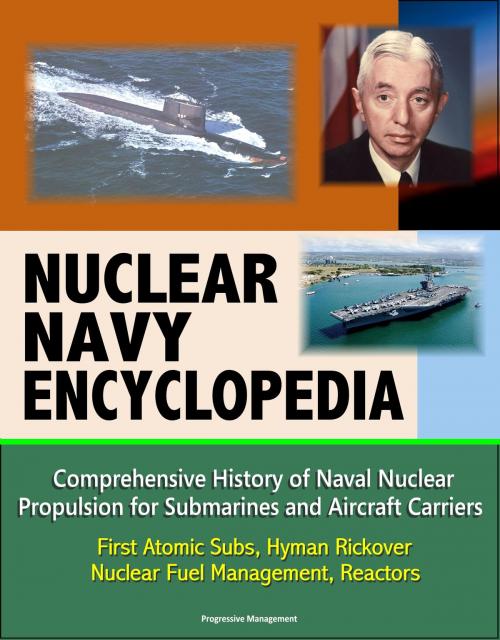Nuclear Navy Encyclopedia: Comprehensive History of Naval Nuclear Propulsion for Submarines and Aircraft Carriers - First Atomic Subs, Hyman Rickover, Nuclear Fuel Management, Reactors
Nonfiction, History, Military, Nuclear Warfare, Naval| Author: | Progressive Management | ISBN: | 9781310880858 |
| Publisher: | Progressive Management | Publication: | August 21, 2014 |
| Imprint: | Smashwords Edition | Language: | English |
| Author: | Progressive Management |
| ISBN: | 9781310880858 |
| Publisher: | Progressive Management |
| Publication: | August 21, 2014 |
| Imprint: | Smashwords Edition |
| Language: | English |
Discover the fascinating stories and history of the U.S. Navy nuclear program. With five official histories and reports, this unique compilation provides a stunning, richly detailed overview of all aspects of this amazing story. Contents: Naval Nuclear Propulsion Program * Nuclear Navy 1946-1962 * Excerpt: Rearming for the Cold War 1945-1960 * Naval Reactors Overview - Naval Spent Nuclear Fuel Management * Excerpt from the Complete Guide to the Idaho National Laboratory (INL).
Naval Nuclear Propulsion Program - This is a comprehensive, up-to-date survey of the U.S. Navy's nuclear propulsion program. Navy warships are deployed around the world every hour of every day to provide a credible "forward presence," ready to respond on the scene wherever America's interests are threatened. Nuclear propulsion plays an essential role in this, providing the mobility, flexibility, and endurance that today's smaller Navy requires to meet a growing number of missions. About 45 percent of the Navy's major combatants are nuclear-powered: 11 aircraft carriers, 53 attack submarines, and 18 strategic submarines (the Nation's most survivable deterrent) — 4 of which were removed from strategic service and converted to a covert, high-volume, precision strike platform designated as SSGN. Advantages of Naval Nuclear Power * Today's Mission * Nuclear-Powered Submarines * Nuclear-Powered Aircraft Carriers * What is the Naval Nuclear Propulsion Program? * Research, Development, and Support Laboratories * Nuclear Component Procurement Organization * Nuclear Equipment Suppliers * Shipyards * Support Facilities and Tenders * Schools and Training Facilities * Headquarters * Establishment of the Program . * Technical and Management Philosophy * The Training Program. * What it Means to be a Sailor in the Naval Nuclear Propulsion Program * Description of a Typical Naval Nuclear Propulsion Plant * Protection of People * Concern for the Environment * Naval Nuclear Propulsion Program Emergency Preparedness * Naval Spent Nuclear Fuel Transportation Exercises * Partnership with State and Local Officials * Naval Nuclear Propulsion Program Accomplishments * Appendix * The First Naval Nuclear Propulsion Plants * Classes of Nuclear-Powered Ships. * Operations * Special Projects * Program Locations * Program Directors — Past and Present * Program Statistics
Nuclear Navy 1946-1962 - This official AEC-sponsored history of the Naval nuclear propulsion program provides an authoritative account of the historic effort to develop the first atomic powered submarines and carriers under the celebrated leadership of Hyman Rickover. Rickover, Nautilus, Admiral Nimitz, President Eisenhower, Walter Zinn, Argonned National Laboratory, Atomic Energy Commission, Bureau of Ships, Nuclear Submarines, Ross Gunn, Naval Research Laboratory, Rear Admiral Mills, General Electric, Babcock and Wilcox, Oak Ridge, Project Genie, Clinton Laboratories, Project Wizard, Reactors (gas cooled, water cooled, liquid metal cooled), Westinghouse, Atomic Power Laboratory, Code 390, Guppy, Tang class, Electric boat, Portsmouth, Mark I and II, Mark A and B, Aircraft Carrier, Atoms for Peace, Shippingport Atomic Power Station, Skipjack, S5W Reactor, Thresher, Polaris, Enterprise Carrier. This history emphasizes the critical role played by individual personalities in the execution of a highly sophisticated, impersonal technological program within a large and sometimes impersonal bureaucracy. Nuclear Navy 1946-1962 * Control of the Sea * The Idea and the Challenge * The Question of Leadership * Structure of Responsibility * Emerging Patterns of Technical Management * Prototypes and Submarines * Toward a Nuclear Fleet * Nuclear Power Beyond the Navy * Propulsion for the Fleet * Building the Nuclear Fleet * Fleet Operation and Maintenance * The Measure of Accomplishment
Discover the fascinating stories and history of the U.S. Navy nuclear program. With five official histories and reports, this unique compilation provides a stunning, richly detailed overview of all aspects of this amazing story. Contents: Naval Nuclear Propulsion Program * Nuclear Navy 1946-1962 * Excerpt: Rearming for the Cold War 1945-1960 * Naval Reactors Overview - Naval Spent Nuclear Fuel Management * Excerpt from the Complete Guide to the Idaho National Laboratory (INL).
Naval Nuclear Propulsion Program - This is a comprehensive, up-to-date survey of the U.S. Navy's nuclear propulsion program. Navy warships are deployed around the world every hour of every day to provide a credible "forward presence," ready to respond on the scene wherever America's interests are threatened. Nuclear propulsion plays an essential role in this, providing the mobility, flexibility, and endurance that today's smaller Navy requires to meet a growing number of missions. About 45 percent of the Navy's major combatants are nuclear-powered: 11 aircraft carriers, 53 attack submarines, and 18 strategic submarines (the Nation's most survivable deterrent) — 4 of which were removed from strategic service and converted to a covert, high-volume, precision strike platform designated as SSGN. Advantages of Naval Nuclear Power * Today's Mission * Nuclear-Powered Submarines * Nuclear-Powered Aircraft Carriers * What is the Naval Nuclear Propulsion Program? * Research, Development, and Support Laboratories * Nuclear Component Procurement Organization * Nuclear Equipment Suppliers * Shipyards * Support Facilities and Tenders * Schools and Training Facilities * Headquarters * Establishment of the Program . * Technical and Management Philosophy * The Training Program. * What it Means to be a Sailor in the Naval Nuclear Propulsion Program * Description of a Typical Naval Nuclear Propulsion Plant * Protection of People * Concern for the Environment * Naval Nuclear Propulsion Program Emergency Preparedness * Naval Spent Nuclear Fuel Transportation Exercises * Partnership with State and Local Officials * Naval Nuclear Propulsion Program Accomplishments * Appendix * The First Naval Nuclear Propulsion Plants * Classes of Nuclear-Powered Ships. * Operations * Special Projects * Program Locations * Program Directors — Past and Present * Program Statistics
Nuclear Navy 1946-1962 - This official AEC-sponsored history of the Naval nuclear propulsion program provides an authoritative account of the historic effort to develop the first atomic powered submarines and carriers under the celebrated leadership of Hyman Rickover. Rickover, Nautilus, Admiral Nimitz, President Eisenhower, Walter Zinn, Argonned National Laboratory, Atomic Energy Commission, Bureau of Ships, Nuclear Submarines, Ross Gunn, Naval Research Laboratory, Rear Admiral Mills, General Electric, Babcock and Wilcox, Oak Ridge, Project Genie, Clinton Laboratories, Project Wizard, Reactors (gas cooled, water cooled, liquid metal cooled), Westinghouse, Atomic Power Laboratory, Code 390, Guppy, Tang class, Electric boat, Portsmouth, Mark I and II, Mark A and B, Aircraft Carrier, Atoms for Peace, Shippingport Atomic Power Station, Skipjack, S5W Reactor, Thresher, Polaris, Enterprise Carrier. This history emphasizes the critical role played by individual personalities in the execution of a highly sophisticated, impersonal technological program within a large and sometimes impersonal bureaucracy. Nuclear Navy 1946-1962 * Control of the Sea * The Idea and the Challenge * The Question of Leadership * Structure of Responsibility * Emerging Patterns of Technical Management * Prototypes and Submarines * Toward a Nuclear Fleet * Nuclear Power Beyond the Navy * Propulsion for the Fleet * Building the Nuclear Fleet * Fleet Operation and Maintenance * The Measure of Accomplishment















